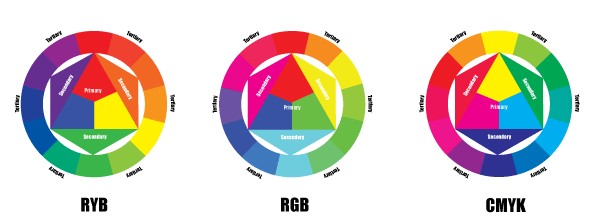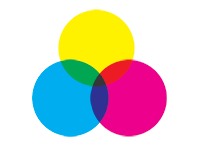In the previous post, we learned about the additive and subtractive color approaches to color. Each one using different principles to blend and create color. Each approach can be applied to different media. The subtractive approach can be used for painting and print. The additive approach can be used for digital media, such as video.
Today we are going to dig a little deeper into this by looking at three different color wheels. We will look at the color wheels with red, yellow, and blue (RYB); cyan, magenta, and yellow (CMYK); and red, green, and yellow (RGB) as the primary colors.
Let's take a look.
 |
| 24 step color wheel |
To understand what a color wheel is, it helps to know what we use it for. We use a color wheel to help us visually organize our colors to better understand how they relate to one another. This means that the color wheel is just a chart in which we organize the different colors in the color spectrum.
You will notice that the colors are arranged along the edge of a circle. The colors are arranged in a circle to show us how the colors interact with each other. The colors next to each other have a particular relationship with each other and will interact together in certain ways. The colors across from each other have a different relationship to each other and will behave differently as compared to the colors they are next to. More on this later.
For now, just note that the colors are grouped together with similar colors. The change from one color to the next is gradual. Though, as we move around the color wheel we will see every color in the spectrum.
You will notice that the colors are arranged along the edge of a circle. The colors are arranged in a circle to show us how the colors interact with each other. The colors next to each other have a particular relationship with each other and will interact together in certain ways. The colors across from each other have a different relationship to each other and will behave differently as compared to the colors they are next to. More on this later.
For now, just note that the colors are grouped together with similar colors. The change from one color to the next is gradual. Though, as we move around the color wheel we will see every color in the spectrum.
Let's look at some color wheels.
RYB, CMYK, and RYB Color Wheels
 |
| Three different color wheels. |
The wheels are named after the primary colors for each system. So it's easy to figure out which colors are the primary colors. For example, the primary colors for the RYB wheel are red, yellow, and blue. Just like the title of the wheel says. The same is true for RGB, it's red, green, blue. CMYK is the same with one addition. The primary colors are cyan, magenta, and yellow. The k in CMYK indicates another color in there and that is black. This is because we are unable to get a true black when mixing colors using CYM, so we add black to solve that problem. (More on this later)
So what is a primary color?
The primary colors are the base colors or starting colors in each color system. We will be using these colors to create all the other colors we need. However, we cannot mix other colors to create the primary colors within each system. For example, in the RYB system, we can mix yellow and blue to make green, but there is no color combination to create yellow. |
| The primary colors. |
If we were to mix all three of the primary colors together we would get either black or white depending on whether the system is additive(RGB) or subtractive (CMYK and RYB). This demonstrates that all of the colors in the spectrum of color can be found within the three primary colors.
Primary, Secondary, and Tertiary Color
The primary colors are the first category of colors on the color wheel. We can separate the colors on the wheel into three different categories. These categories are primary colors, secondary colors, and tertiary colors. The name of each group tells us something about the colors. That is that there is an order to the colors; primaries are first, secondaries are next and tertiaries are third.What are Secondary Colors?
We know what a primary color is but what is a secondary color? If we were to mix two of the primary colors together we will get a new color. This new color mixed from the two primary colors is called a secondary color. For example, in the RYB system, red and yellow mix to make orange. Secondary colors have a special relationship with the primary colors, but more on that when we discuss complementary colors. |
| The secondary colors. |
An interesting side note: Take a look at the secondary colors for the RGB and CYMK color wheels you may notice something interesting. That's right, the secondary colors for each are the primaries for the other. The secondary colors for the CMYK wheel are red, green, and blue. Those are the primaries for the RGB wheel.
What are Tertiary Colors?
We know what primary and secondary colors are but what are the tertiary colors? Taking what we know about how to make a secondary color we can probably figure out what a tertiary color is.
The tertiary colors are all the rest of the colors in the color spectrum. We can get a tertiary color by mixing a primary and a secondary, or two secondary colors. We can adjust the hue of the tertiary color by the amount of each color that is mixed together. For example, we know that yellow and blue make green but we can control what kind of green we make. If we add more yellow than blue we get a yellower blue. If we add more blue than yellow we get a bluer green. Understanding this we can create any color in the spectrum.
 |
| The tertiary colors. |


